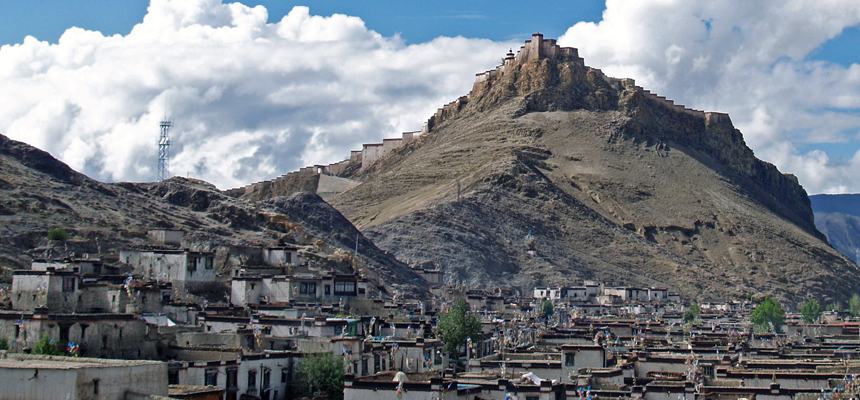A small agricultural town famous for its wool carpets and the Palkor Choide Chorten, Gyantse lies between a Monastery and a fort in the Nyang-chu Valley on fertile grounds along an old trading route. Before 1959, traders coming from Kalimpong and Gangtok in India would enter Tibet through Yadong traveling on to Gyantse, en route to Lhasa.
Palchor Choede Monastery and KUMBUM:
NamoPalchor Choide Monastery is located west of Gyantse city and founded in 1418 jointly by Kedup Je of the Gelugpa Sect and Rabten Kunsang of the Sakyapa Sect. The Palchor Monastery is enclosed by mountains in the east, west and north and has a special influence over Tibet’s Buddhism owing to its unification of three different sects, the Gelukpa, the Sakyapa and Bhuton Sects who were all worshiped in this Monastery.
The famous Kumbum pagoda stands nine stories high and has 108 doors and 77 chapels. It contains clay sculptures and various murals. The pagoda is said to have 100,000 images, either sculpted or painted, this is the reason for its name Kumbum, literally meaning “100,000 Images”. Chortens are receptacles of worship, similar to the stupas of India, with many sacred objects within: statues, books, frescoes and items of gold and silver. The Gyantse Chorten is a deluxe model, and is quite innovative in its architecture, it has about 70 interlocking chapels that you see as you spiral your way up the six floors to the golden plume at the top. Each chapel is richly, often grotesquely, decorated with thousands of frescoes, statues and artifacts and lined with Buddhist texts inscribed in Sanskrit.
In aerial perspective, the chorten is supposedly shaped like a Mandala, the embodiment of the Lamaist universe. Pilgrims circumambulate this giant wedding-cake, the inner spiraling circuit of the Chorten is a meditational aid to enlightenment with the top canopied section representing the highest plane wisdom. As you wind your dizzy way to the top, you begin to appreciate this principle.
The Fort (Gyantse Dzong):
NamoThe thick walls and the building-shells of this fort are much better preserved than other forts around Tibet, but it is very difficult to get to see this 500- years- old colossus. You have to somehow try and get hold of a key from a white house at the base, toward the south-eastern side. Ingeniously for times of siege, the fort had its own well dug within the walls. It is not known if they are still in place. In 1904 500 soldiers of the Gyantse fort held the fort for several days against the British forces before they were overcome.


Comments